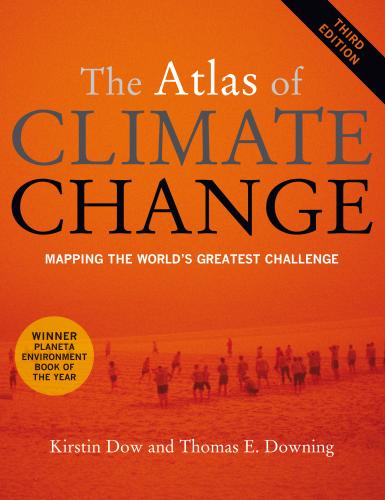“Concise in expression, with handsome cartography and a text that sticks to the facts, it elucidates the key issues surrounding global climate change.” Kirkus Review “Seeing that climate change is probably the biggest single problem facing our world today, it’s natural that you might want to find out more. You could wade through dense, dry academic detail from the IPCC. Or you could root out the newly published Atlas of Climate Change, which condenses key findings from the scientists and is packed with facts, graphs, and maps explaining how climate change is affecting the planet.” Guardian “This is a remarkable piece of work and extremely readable. What is heartening is not only the wealth of information it conveys but also the powerful illustrations and graphics.” Director-General, The Energy and Resources Institute (TERI) “This pioneering atlas will become an essential point of reference for anyone looking for a quick and accurate overview of this multidisciplinary subject.” Foreign and Commonwealth Office, UK “An excellent book and wonderful tool to help clarify the mountains of data into something comprehensible. If you want to get up to speed on the subject, this is probably the best place to start. Highly recommended.” Transition Culture “An excellent vehicle for beginning to understand the climate change issue.” Forestry Chronicle, Canada “Packs a lot of very high quality information into a small space with an excellent layout. A hit with students and essential for every library shelf – one of the best buys of the year.” Ecological and Environmental Education “If you want to understand the evidence, causes, and consequences of climate change, as well as what we can do to deal with it, get your copy today.” CarbonSense “A succinct, yet exacting new resource that will be vital for many years to come.” Oxford University Centre for the Environment “This vast mine of information takes a wider than usual view of the implications of climate change. It is a valuable resource to help understand the core issues and puts into perspective the desperate unfairness of the global picture.” Morning Star “All schools and colleges should complement their environment studies with this atlas.” Education Journal
In the same series:
“Unique and uniquely beautiful. . . . A single map here tells us more about the world today than a dozen abstracts or scholarly tomes.” — Los Angeles Times “A striking new approach to cartography. . . . No one wishing to keep a grip on the reality of the world should be without these books.” — International Herald Tribune
The Atlas of
CLIMATE change
Mapping the World’s Greatest Challenge Third Edition Kirstin Dow and Thomas E. Downing
UNIVERSITY OF CALIFORNIA PRESS
University of California Press, one of the most distinguished university presses in the United States, enriches lives around the world by advancing scholarship in the humanities, social sciences, and natural sciences. Its activities are supported by the UC Press Foundation and by philanthropic contributions from individuals and institutions. For more information, visit www.ucpress.edu. University of California Press Oakland, California Copyright © Myriad Editions Limited 2006, 2007, 2011 All rights reserved The moral rights of the authors have been asserted Library of Congress Control Number: 2011922284 ISBN: 978-0-520-26823-4 (pbk. : alk. paper) ISBN (ebk): 978-0-520-96682-6 Produced for University of California Press by Myriad Editions Brighton, UK www.MyriadEditions.com Edited and coordinated by Jannet King and Candida Lacey Designed by Isabelle Lewis and Corinne Pearlman Maps and graphics created by Isabelle Lewis This ebook edition has been created using CircularFLO from Circular Software This book is sold subject to the condition that it shall not by way of trade or otherwise, be lent, re-sold, hired out, or otherwise circulated without the publisher’s prior consent in any form of binding or cover other than that in which it is published and without a similar condition including this condition being imposed on the subsequent purchaser.
Voices & Visions of Our Future 9 Wangari Maathai Philippe Cousteau About the Authors 10 Introduction 11 Definition of Key Terms 16 PART 1 SIGNS OF CHANGE 21 1 Warning Signs 22 The array of extreme events in 2010 stand out among thousands of signs of climate change. 2 Polar Changes 24 Warming in the polar regions is driving large-scale melting of ice that will have both local and global consequences. 3 Shrinking Glaciers 26 Glaciers are losing mass and are in retreat. 4 Ocean Changes 28 Oceans are getting warmer and more acidic, affecting marine life. 5 Everyday Extremes 30 The frequency of some extreme events is increasing. PART 2 The Changing Climate 33 6 The Greenhouse Effect 34 The intensification of the greenhouse effect is driving changes in the Earth’s climate. 7 The Climate System 36 The entire climate system is adjusting to an increase in the heat trapped in the Earth’s atmosphere. 8 Interpreting Past Climates 38 Concentrations of CO2 and CH4 are higher than at any time in the last 650,000 years. 9 Forecasting Future Climates 40 Global temperatures are predicted to continue rising. 10 Climate & Social Crises 42 Climate change results from complex interactions in the natural environment, coupled with social and economic changes. PART 3 DRIVING CLIMATE CHANGE 45 11 Emissions Past & Present 46 Most greenhouse gases have been, and are, emitted to meet the needs of modern industrial societies. 12 Fossil Fuels 48 The emission of greenhouse gases from the burning of fossil fuels is the major cause of climate change. 13 Methane & Other Gases 50 A range of greenhouse gases contribute to climate change. 14 Transport 52 International trade and travel, and dependence on motor vehicles make transport a major source of greenhouse gas emissions.
Contents
